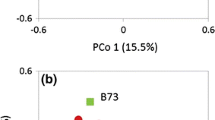Abstract
Maize (Zea mays L.) production has significantly expanded into very short-season environments where germination and growth in cooler environments is essentially a pre-requisite. Therefore, an important goal for maize breeders is to improve local germplasm sources of inbred lines that are able to grow under these challenging conditions. The objective of this research was to evaluate direct and correlated responses in two improved early maturing maize populations [NDSCD(M)C10 and BS22(R)C7] after two cycles of S1 and full-sib intra-population recurrent selection for cold tolerance. The S1 and full-sib progenies were obtained by self-pollinating 100 random plants and by intercrossing 200 random plants, respectively. Ten percent of the families were selected, based on an index that included emergence percentage, seedling vigor, and root lodging percentage, and recombined at the same time in a summer nursery based upon data across northern North Dakota locations. The essential benefit of this breeding methodology was to achieve one year per cycle of selection based upon progenies. However, direct response to selection was not significant while some correlated responses were significant. We decided to report these results in order to encourage other scientists the evaluation of additional sources of germplasm, the screening at various dates, and the selection of target environments with more intensive cold stress before initiating long-term selection programs for cold tolerance. In addition, further research on the current and alternative long-term selection methods for cold tolerance is recommended for continuous genetic improvement of advanced cycles in the northern U.S. Corn Belt.




Similar content being viewed by others
References
Carena MJ (2008a) Development of new and diverse lines for early-maturing hybrids: traditional and modern maize breeding. In: Prohens J, Badenes ML (eds) Modern variety breeding for present and future needs. EUCARPIA, Valencia, Spain
Carena MJ (2008b) Increasing the genetic diversity of northern U.S. maize hybrids: integrating pre-breeding with cultivar development. In: Conventional and molecular breeding of field and vegetable crops. Novi Sad, Serbia
Carena MJ, Wanner D (2009) Development of genetically broad-based inbred lines of maize for early maturing (70–80RM) hybrids. J Plant Regist 3(1):107–111
Carena MJ, Wicks ZW (2006) Maize population hybrids: an exploitation of US temperate public genetic diversity in reserve. Maydica 51:201–208
Carena MJ, Eno C, Wanner DW (2008) Registration of NDBS11(FR-M)C3, NDBS1011, and NDBSK(HI-M)C3 maize germplasms. J Plant Regist 2:132–136
Carmer SG, Seif RD (1963) Calculation of orthogonal coefficients when treatments are unequally replicated and/or unequally spaced. Agron J 55:387–389
Cross HZ (1988) Registration of NDSCD, NDSK(FS)C1, and NDSF maize germplasm. Crop Sci 28:201–202
Fisher RA, Yates F (1957) Statistical tables for biological, agricultural and medical research, 5th edn. Hafner Publishing Company, NY
Hallauer AR, Carena MJ (2009) Maize breeding. In: Carena MJ (ed) Cereal breeding, chap 1. Springer, NY (in press)
Hallauer AR, Russell WA, White PR (2000) Registration of BS21(R)C6 and BS22(R)C6 maize germplasm. Crop Sci 40:1517
Hoard KG, Crosbie TM (1985) S1 line recurrent selection for cold tolerance in two maize populations. Crop Sci 25:1041–1045
McConnell RL, Gardner CO (1979) Selection for cold germination in two corn populations. Crop Sci 19:765–768
Melani MD, Carena MJ (2005) Alternative maize heterotic patterns for the Northern Corn Belt. Crop Sci 45:2186–2194. doi:10.2135/cropsci2004.0289
Mock JJ, Bakri AA (1976) Recurrent selection for cold tolerance in maize. Crop Sci 16:230–233
Mock JJ, Eberhart SA (1972) Cold tolerance in adapted maize populations. Crop Sci 12:466–469
Revilla P, Malvar RA, Cartea ME, Butron A, Ordas A (2000) Inheritance of cold tolerance at emergence and during early season growth in maize. Crop Sci 40:1579–1585
SAS (1989) SAS/STAT user’s guide. Version 6, vols 1 and 2, 4th edn. SAS Inst. Inc., Cary
Steel RGD, Torrie JH, Dickey DA (1997) Principles and procedures of statistics: a biometrical approach, 3rd edn. McGraw-Hill, NY
Author information
Authors and Affiliations
Corresponding author
Additional information
Part of the thesis submitted by B. Sezegen in partial fulfillment of the requirements for a MS degree at North Dakota State University.
Rights and permissions
About this article
Cite this article
Sezegen, B., Carena, M.J. Divergent recurrent selection for cold tolerance in two improved maize populations. Euphytica 167, 237–244 (2009). https://doi.org/10.1007/s10681-008-9875-2
Received:
Accepted:
Published:
Issue Date:
DOI: https://doi.org/10.1007/s10681-008-9875-2




